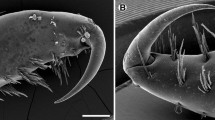Abstract
Feeding units — viz. triplets of unequally-sized podia associated with protective lappets — occur all along the pinnules of adult Antedon bifida (Pennant). Small food particles are trapped by direct mucus impingement to the wall of primary and secondary podia (there are no mucus net or mucus thread helping in this process). Large particles are caught by primary and secondary podia which partly curl over them. Small particles accumulate on the collecting podia before being transferred to the groove, while large particles are transferred one by one. Transfer of particles to the groove occurs by wiping the collecting podia on the ciliary tracts against the ciliary current. When active, tertiary podia always paddle against the ciliary current. They serve in bolus formation (mucus embedding of food particles), but do not participate in bolus compaction or propulsion. Elimination of unwanted particles occur through the action of secondary podia whose movements may disrupt the lappet's palisade, thus creating a sideward current that moves particles from the groove to the outside. Typical podial triplets do not occur along brachial and calycinal grooves. Both brachial and calycinal podia function mostly in guiding and regulating particle flow. The feeding structures of early pentacrinoid larvae of Antedon bifida recall to mind those of pinnules of adult individuals. They consist of twenty-five podia arranged in five radial triplets alternating with five interradial pairs. They are similar to the pinnular feeding structures of adults in that they have both collecting (radial) and paddling (interradial) podia.
Similar content being viewed by others
Literature cited
Byrne, M. and A. R. Fontaine: The feeding behaviour of Florometra serratissima (Echinodermata; Crinoidea). Can. J. Zool. 59, 11–18 (1981)
Byrne, M. and A. R. Fontaine: Morphology and function of the tube feet of Florometra serratissima. (Echinodermata, Crinoidea). Zoomorphology 102, 175–188 (1983)
Gislén, T.: Echinoderm studies. Zool. Bidr. Uppsala 9, 1–316 (1924)
Holland, N. D.: An electron microscopic study of the papillae of crinoid tube feet. Pubbl. Staz. zool. Napoli 37, 575–580 (1969)
Holland, N. D. and H. Kubota: Correlated scanning and transmission electron microscopy of the feather star Comanthus japonica (Echinodermata: Crinoidea). Trans. Am. Soc. 94, 58–70 (1975)
Lahaye, M. Ch.: Comportement alimentaire et structures digestives d'Antedon bifida (Pennant) (Echinodermata, Crinoidea, Antedonidae), 70 pp. M. Sc. thesis, Université Libre de Bruxelles 1982.
La Touche, R. W.: Feeding behaviour of the featherstar Antedon bifida. J. mar. biol. Ass. U.K. 58, 877–890 (1978)
Meyer, D. L.: Food and feeding mechanism: Crinozoa. In: Echinoderm nutrition, pp 25–42. Ed. by M. Jangoux and J. M. Lawrence. Rotterdam: Balkema 1982
Mladenov, P. V. and F. S. Chia: Development, settling behaviour, metamorphosis and pentacrinoid feeding and growth of the featherstar Florometra serratissima. Mar. Biol. 73, 309–323 (1983)
Nichols, D.: The histology and activities of the tube-feet of Antedon bifida. Q. J. microsc. Sci. 101, 105–117 (1960)
Reichensperger, A.: Über das Vorkommen von Drusen bei Crinoiden. Zool. Anz. 33, 363–369 (1908)
Zmarzly, D. L. and N. D. Holland: Rates of food transport down the ambulacral grooves and through the gut of Comanthus bennetti (Echinodermata, Crinoidea), observed in situ. Mar. Ecol. Prog. Ser. 6, 229–230 (1981)
Author information
Authors and Affiliations
Additional information
Communicated by O. Kinne, Oldendorf/Luhe
Rights and permissions
About this article
Cite this article
Lahaye, M.C., Jangoux, M. Functional morphology of the podia and ambulacral grooves of the comatulid crinoid Antedon bifida (Echinodermata). Mar. Biol. 86, 307–318 (1985). https://doi.org/10.1007/BF00397517
Accepted:
Issue Date:
DOI: https://doi.org/10.1007/BF00397517




